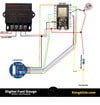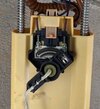Hi All,
First post on the forums, and in need of a bit of help. I've always tinkered with electronics but have never really learned the basics, just what I needed to know when I needed to.
I'm building a "sort-of" replica of KITT from Knight Rider and have created a custom dash from a 19" touch screen, 24" touch screen, 10" Android Tablet and an incar-pc, all of which somehow doesn't include the ability to have a fuel gauge.
Enter Arduino/ESP32 and I'm trying to follow a guide from King6Fab.com for a ESP32 controlled GC9A01 1.28" LCD display to make a pod fuel gauge for my car.
The fuel sender uses a 5v reference in one end and a float that moves a (grading?) resistor from 240ohms at full to ~33ohms at empty, which as I understand it is read as a voltage back at the display end which drops based on how much resistance is added from the float sensor.
As I understand it, the ESP32 boards can only read/handle 0-3.3v so the 5v needs to be brought down to this range to work.
So I either need to bring 5v down to 3.3 on the receiving pin, or alternatively use 3.3v reference and adjust the read voltage on the receiving end, which I need to do anyway.
So here are my 2 questions:
In the attached diagram I am unclear as to what the 100 Ohm resistor's purpose is. Would this be bringing the voltage down, or just adjusting the resistance range (The original design for this was for a 0-190 ohm sensor, but is said to work with any fuel sender range)?
Secondly, in the diagram, the resistor is connected between the 5v reference and the fuel sender, but then the Pin15 which is reading the signal(return signal from the sender after passing through the addon resistor) is connected to the fuel sender side of the resistor which is also supplying the voltage to the fuel sender. That is, there is no 2nd wire coming from the fuel sender, which I would assume is needed: a reference voltage, and a modified varying voltage based on fuel tank level.
Am I not understanding the concept here, or is the diagram wrong?
The only 2 reasons I could see for the single wire, is either the original design accounts for the original car's wiring to continue to supply the original voltage, but then why is the 5v being used?
Or the sender unit uses a ground and measures the resistance that way, but I was of the understanding the ESP & Arduino pins can't measure resistance directly, and it would need a board ground to do this accurately anyway?
Any help for this is greatly appreciated.
First post on the forums, and in need of a bit of help. I've always tinkered with electronics but have never really learned the basics, just what I needed to know when I needed to.
I'm building a "sort-of" replica of KITT from Knight Rider and have created a custom dash from a 19" touch screen, 24" touch screen, 10" Android Tablet and an incar-pc, all of which somehow doesn't include the ability to have a fuel gauge.
Enter Arduino/ESP32 and I'm trying to follow a guide from King6Fab.com for a ESP32 controlled GC9A01 1.28" LCD display to make a pod fuel gauge for my car.
The fuel sender uses a 5v reference in one end and a float that moves a (grading?) resistor from 240ohms at full to ~33ohms at empty, which as I understand it is read as a voltage back at the display end which drops based on how much resistance is added from the float sensor.
As I understand it, the ESP32 boards can only read/handle 0-3.3v so the 5v needs to be brought down to this range to work.
So I either need to bring 5v down to 3.3 on the receiving pin, or alternatively use 3.3v reference and adjust the read voltage on the receiving end, which I need to do anyway.
So here are my 2 questions:
In the attached diagram I am unclear as to what the 100 Ohm resistor's purpose is. Would this be bringing the voltage down, or just adjusting the resistance range (The original design for this was for a 0-190 ohm sensor, but is said to work with any fuel sender range)?
Secondly, in the diagram, the resistor is connected between the 5v reference and the fuel sender, but then the Pin15 which is reading the signal(return signal from the sender after passing through the addon resistor) is connected to the fuel sender side of the resistor which is also supplying the voltage to the fuel sender. That is, there is no 2nd wire coming from the fuel sender, which I would assume is needed: a reference voltage, and a modified varying voltage based on fuel tank level.
Am I not understanding the concept here, or is the diagram wrong?
The only 2 reasons I could see for the single wire, is either the original design accounts for the original car's wiring to continue to supply the original voltage, but then why is the 5v being used?
Or the sender unit uses a ground and measures the resistance that way, but I was of the understanding the ESP & Arduino pins can't measure resistance directly, and it would need a board ground to do this accurately anyway?
Any help for this is greatly appreciated.


